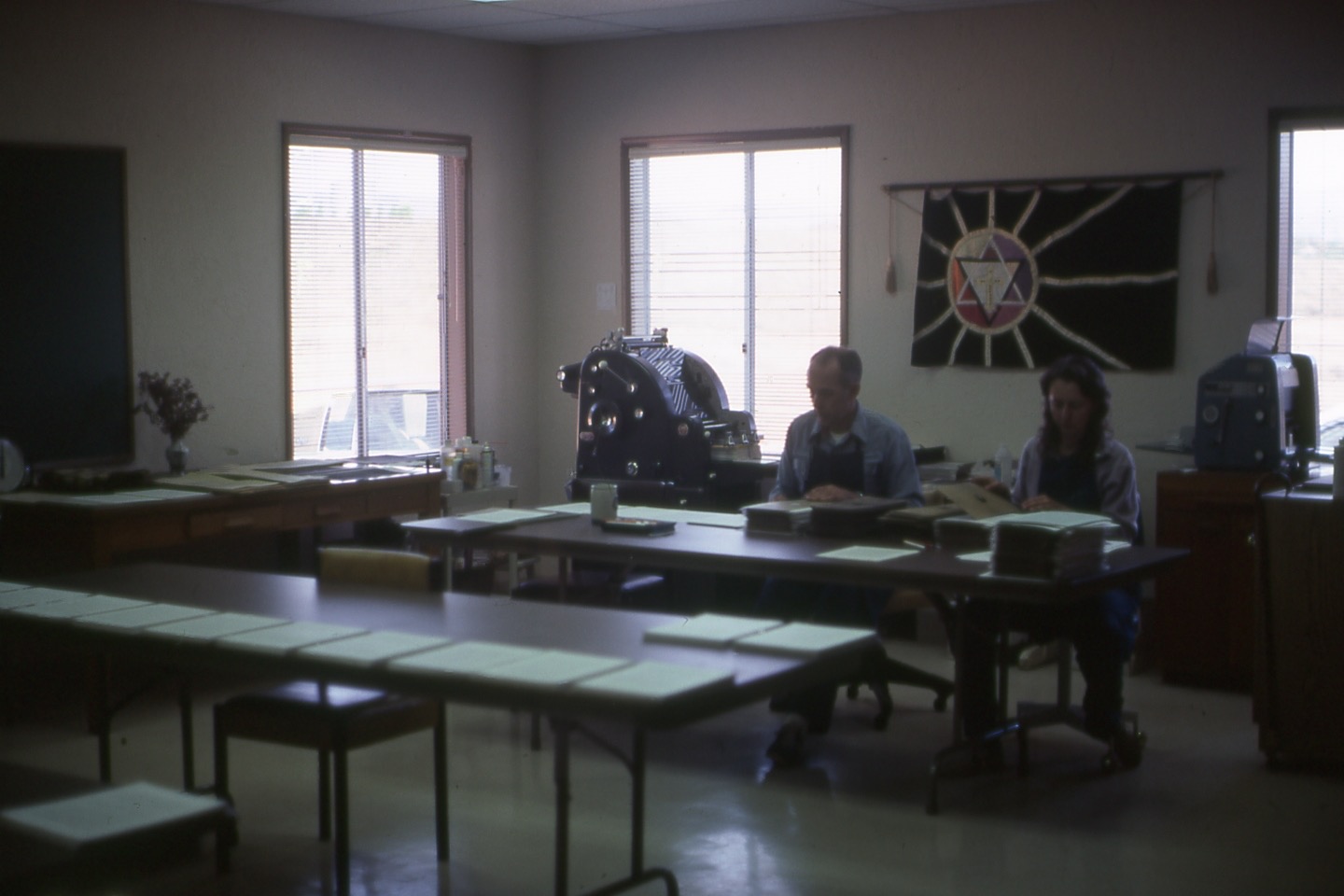Balance. Purpose. Enlightenment.
From the Twenty-Five Years Ago Column
In the elder days of Art,
Builders wrought with greatest care
Each minute and unseen part;
For the gods see everywhere.
– Henry W. Longfellow
We learn a lot by thinking about the past and trying to learn from our earlier struggles and triumphs. The printing of lessons and literature is one of the Fellowship’s major activities and has offered much learning to those who have been part of this activity over the years. Here is a report on the printing from twenty-five years ago, that might give a feeling for why we’re involved in some of the many mundane tasks we do here.
From the time the Fellowship was inaugurated, it has printed as much of its own material as it could, and like the Crafts, printing has provided many chances for hands-on experience with some very practical skills.
Until recently, our copy was painstakingly typed on old reliable manual typewriters. Precision becomes very important when each mistake must be carefully corrected by hand. For 35 years, Fellowship bulletins and lessons were printed on a mimeograph machine. This involves using a typewriter to actually cut the letters into a stencil, so ink can squeeze through it to make the final impressions on sheets of paper. Precision is even more in demand, because if you make a mistake on the stencil, you paint over the error with a substance like fingernail polish, try to roll the stencil back to its exact position, and retype – hoping the new letter or letters line up with the old. Sometimes, the typewriter would cut the centers of the o’s and tops of the e’s completely out of the stencil and you had to crawl around on your hands and knees to find the missing pieces and carefully set them back in.
It wasn’t easy to get professional looking copy with this rather crude system, and in these times of word processors and laser printers, it bears thinking about the patience and loving care that went into those early efforts. Those early typists and printers strove for a high standard of performance which has constantly been raised over the years. Those of you who are involved with the printing today know something about tolerances we try to work to. Margins are closely observed, and we print the lines on our pages straighter than our current computer printer is able to do. That’s important, because the lines on one side of the page are registered, or matched, to those on the other side –– a mark of quality not always observed in printed books you may buy.
The Fellowship staff printed its lessons and bulletins until 1971, when Order members were trained for this responsibility. In 1973, we made our first attempt to print INTO THE SUN on a duplicator. Three years later, we acquired our A.B. Dick press and then came the challenge of learning to use it properly. Our first efforts were not too auspicious, as you could see if I were to show you the 9th edition of INTO THE SUN that was printed on the A. B. Dick press the first year we had it . . . but I’m not going to show it to you. However, it wasn’t long before we were producing our own stationery and envelopes too. And for the last 21 years, the Order has done almost all the printing for the Fellowship, except for THE SUN RISES.

Like everything in the Work, we try to balance the practical with the idealistic. A good example is the Fellowship stationery everyone is familiar with. A distinctive design, to be sure, but did you know it has a practical side too? Not only does the letterhead help us line up our margins for typing, it is also a guide for folding single-sheet letters.
Since none of us were printers to start with, there has been a lot of hard learning with this Lemurian endeavor. In the beginning, there were times we thought we couldn’t do it –– when we struggled for a whole day without producing a single passable copy. We talked with printers and Fellowship people who were familiar with this work, and tried again. Gradually, we got the hang of it, and along with it, a better understanding of virtues like precision, efficiency, and discrimination, not to mention tolerance, kindliness, and charity. We also earned something priceless –– the confidence that we could start out on some completely new undertaking that we knew nothing about and carry it to a successful point. This is something we can carry into all our Lemurian endeavors, that they may all help us learn so much.
Copyright © 2021 Lemurian Fellowship
2 thoughts on “From the Twenty-Five Years Ago Column”
Comments are closed.


We enjoyed your unintended pun and fun story, Eric!
There was something about the mention of the “old reliable manual typewriters” that rang a bell with me. (No pun intended!) I recently read an article about some authors and journalists returning to these typewriters in place of computers to do their writing. It seems that there is something about physically making that lever strike the paper with a solid “thwack” that makes you feel you are actually doing work to create a word. The idea of typing without a mistake was a measure of pride, as it took time to erase a word and retype it. I thought back to my typing class in High School and the first time I was able to type 30 wpm on a full sheet with no errors. No back space and delete in those days!
Precision and Efficiency are easier to achieve in printed word these days. However, I think when chiseling a word on a stone tablet you had more incentive not to make a mistake!